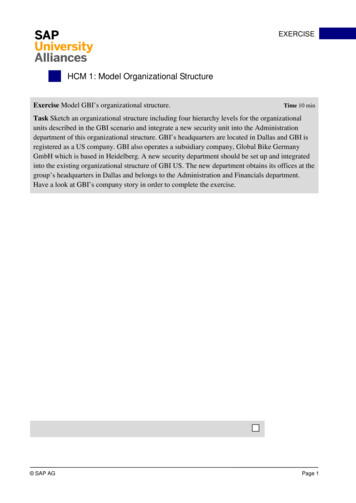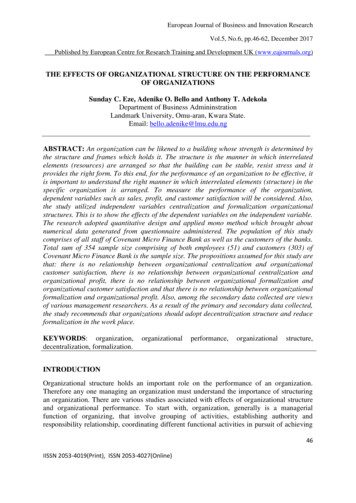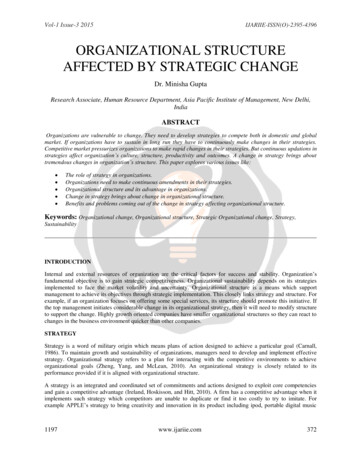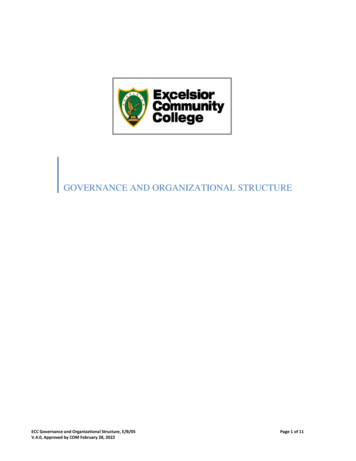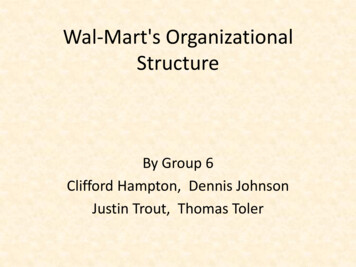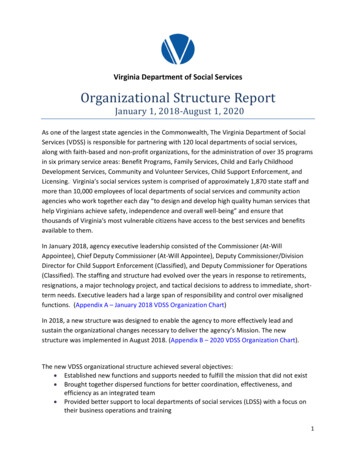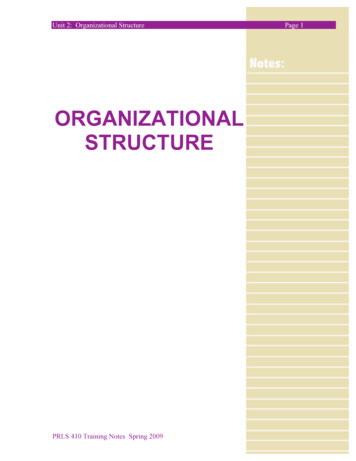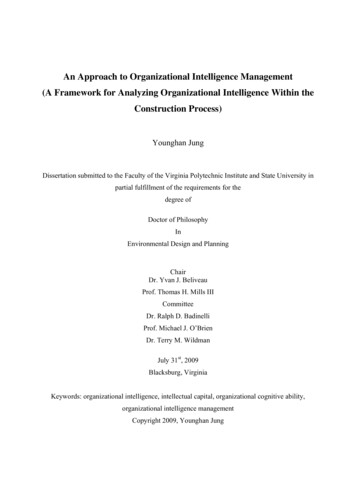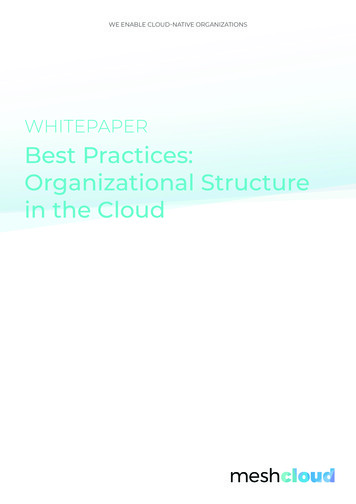
Transcription
WE ENABLE CLOUD-NATIVE ORGANIZATIONSWHITEPAPERBest Practices:Organizational Structurein the Cloud
IntroductionYour key takeaways from this whitepaper:Not properly planning and executing organizationalstructure in the cloud costs companies efficiency,security, and digital sovereignty.This whitepaper provides insight into the bestpractices that have emerged for organizationaldesign in the cloud:We at meshcloud regularly discuss the challengesof organizational structure in the cloud with ourcustomers. Following the recommendations of thecloud service providers is often not the best way togo: Modeling an enterprise’s structure in the cloud regions, departments, business units - comes withserious downsides.Focus on a use case structure or anapplication-based structure, instead oforganizational structure.Reduce the number of redundancies e.g.instead of having multiple similar folders ina lower level trying to generalize in an upperlevel (differentiation of location under rootinstead of having these in each)Focus on global optimization in a higherabstraction layer instead of optimizing eachcloud platform individually in a siloUse cloud provider native tools to defineyour security baselineWe have found that a flatter hierarchy unlockspotential that would otherwise be buried under piledup hierarchical layers.3. A best-practice Model for Cloud Organizations4. Why we don’t follow the Organizational Structure proposed by Cloud ProvidersIn the example case of Likvid Bank’s mobile banking app, we’ll show how meshcloud can be utilized to build anefficient organizational structure in the cloud – independently from specific cloud service providers.Let’s get started with the basics.The answer to this one is: You don’t know. Companies and cloud usage evolve and the organizational structuremodel should be robust against these changes. Responsibilities of departments for IT projects change overtime and IT projects move between departments, or maybe the departments themselves will be reorganized.These events would require major remodeling if the organizational structure in a multi-cloud environment ismodeled after your departments.A cloud journey is as much an organizational journey as it is a technological one. One central piece of thispuzzle is the creation of a central cloud team: Cloud Foundation, Cloud Competence Center or Cloud Centerof Excellence - many names, one core concept: Centralizing cloud governance to enable more productive,more agile, and more innovative DevOps.Cloud governance is not platform-specific – and so it does not make sense to reinvent the cloud governancewheel for every platform in every silo. In a cloud foundation team boundaries and best practices can beshared better and faster leading to better platform-specific implementations.Application Teams3 Guiding Questions when designing your organizationalstructure in the cloudWhen we help our customers on their cloud journey we always ask them three questions regarding their cloudorganization:1. How do you want your teams to work?How to work on projects and use cases is a big question and the answer boils down to: You need the rightpeople for the right job. Sounds obvious but in traditional enterprise hierarchies, it’s not always easy to makeit come to reality: You need to gather a team of specialists and these specialists may work in differentdepartments. Most goals can only be achieved if various departments work cooperatively.The best example is DevOps, where you want a cultural mind change to break free from silos – like departmentborders.WE ENABLE CLOUD-NATIVE ORGANIZATIONSWhat will the organization look like in the future?A central Cloud Foundation Team owning Cloud Governance2. Fundamentals of Cloud OrganizationHow do you want your teams to work?Many initiatives start as IT projects and then eventually turn into regular operations or are discontinued ifnothing comes of it.Your Cloud Organization1. Guiding Questions when designing your Cloud Organization3. What will the organization look like in the future?The second is how you want IT projects to be managed – avoiding bottlenecks and enabling teams to selforganize and drive innovation. To achieve this, a certain degree of sovereignty for the teams is necessary:This means you want to have self-service for every IT project, rights and role structure, chargeback, andmetadata, to enable teams to allocate costs on dedicated budgets and cost centers within their organization.Fundamentals of Cloud OrganizationsThis whitepaper talks about:2. How do you want your IT projects managed?How do you want your IT projects managed?Application Teams are formed around a specific application – they are responsible for that application andits implementation in the cloud. These teams can be seen as customers of the cloud foundation.Application teams can very much be cross-functional with members from different departments: Keep inmind how often enterprises restructure their organization when designing an organizational structure.Use Cases, Applications or IT SystemsThe goal of moving to the cloud ist the implementation of IT applications in the cloud. The cloud foundationteam takes care of organizational overhead and central cloud governance questions.Most of our customers have specific goals related to their cloud strategy. Often they look something like this:- move 80% of IT applications to the cloud by 2022 to gain flexibility- implement all new use cases in a cloud-native manner- close down a data center by the end of 2023The cloud foundation team is there to serve these use cases.Reaching these goals is often part of a strategic initiative driven byC-level and top management to leverage the competitive advantageof cloud-native IT and faster time-to-market.
Application EnvironmentsThe meshModel – A bestpractice model to map yourorganization to the cloudCloud-native applications follow an agile developmentprocess: This includes continuous integration, DevOps,Infrastructure-as-Code (IaC), resulting in a continuousdelivery process.To design an effective organizational structure in thecloud, you have to define a mapping between yourown organizational concepts and the cloud provider’scapabilities.Part of a cloud-native continuous delivery process is theuse of multiple stages for an application: Especially whenstarting an application’s lifecycle, teams start buildingtheir applications in a development environment, beforeexpanding to further stages.As technologies continuously evolve, it makes senseto focus this design on your organization, rather thancloud-specific concepts that may be outdated over time.This will enable you to minimize switching costs, whentechnological changes occur. At the same time, you’llwant to leverage the specific technical capabilities eachcloud provider offers for implementing your security andcompliance requirements.With our customers we see between three and fivestages: Common examples are a development, a qualityassurance, and a production stage.Depending on the stage different security or compliancerequirements may apply and must be enforced.We believe that modeling your organization in thesuggested way drives the success of your cloudtransformation journey. While the model works withoutthe use of our cloud governance platform meshStack, theuse of meshStack provides clear integration interfacesand seamlessly interconnects your core organizationalconcepts with the tools and capabilities offered by thecloud providers to enable you to become a cloud-nativeorganization.Organizational Structures of CloudProvidersMost cloud providers like AWS, Azure, and Google Cloudprovide tools and means to map your organizationalstructure to the cloud (AWS Organizational Units, AzureManagement Groups or Google Folders).Resource Hierarchies for AWS, Azure and GCPIn this section, we’ll describe the resource hierarchies of AWS, Azure, and GCP on a very high level. Theresource hierarchy refers to the organization of resources inside a cloud platform account. The three bigproviders offer several levels, some of which are optional:Cloud Foundation – meshPartnerThe cloud foundation takes an overarching role in cloud-native organizations. It’s a construct that drivesefficiency and really helps to leverage the benefits of the cloud for large organizations.Cloud foundation teams carry responsibility for basic cloud governance processes like IAM, TenantManagement, Security & Compliance and Billing. These processes are part of every cloud organization andcan be implemented in different ways.There are 2 main aspects to the work of cloud foundations:1. Portfolio & Configuration: The cloud foundation integrates the cloud platforms that are to be offered toDevOps teams into existing organizational processes. They perform platform configurations, e.g. by definingwhich organizational units exist, what policies apply and how internal roles map to specific roles in the cloud.It is their responsibility to define a security baseline for all use cases run in the cloud, based on providertooling.2. Transparency: As gate keepers of the cloud, cloud foundation teams have to keep an overview on ongoingcloud activities across the entire organization: Who is using the cloud, which tenants exist, who is responsiblefor them.AWS and GCP allow for the cloud tenant (subscription or project) to be the highest up in the resource hierarchy.Azure requires you to have a root management group for all tenants, that can’t be moved or deleted. Azurealso requires you to have at least one resource group – a level that the other two providers do not have at all.The levels determine the inheritability of policies, how access is managed, and so on. These levels are yourbuilding blocks to map your organization to the cloud.One core concept of being cloud-native is self-service enablement. The idea behind our platform meshStackis to enable Cloud Foundation teams to centrally define and configure the cloud platforms used in theorganization, while DevOps teams get to provision cloud-native environments in self-service based on thesedefinitions.In this context Cloud Foundation teams act as a partner to the DevOps teams that aim to move their applicationsto the cloud, resulting in the corresponding organizational concept on our platform - the meshPartner.WE ENABLE CLOUD-NATIVE ORGANIZATIONS
Best Practices for structuring AWS accounts, Azuresubscriptions, and GCP projectsUse Case – meshCustomerThe goal of your cloud journey is to build or migrate applications to the cloud. This means that use cases, ITapplications, IT systems, you name it, are really the core of your cloud activities.The best practice for using your cloud tenants (AWSaccounts, Azure subscriptions, and GCP projects) is to haveone for each stage of each application. That means forexample one AWS account for the development stage of amobile app, one for test, and one for production.Within meshcloud, we represent these use cases as meshCustomers. A common workflow is that the productowner of a use case goes through the onboarding process in self-service, usually by providing informationlike a description, responsible people, assigned budgets or processed data types.Actually, IT use cases or applications are not new to thecloud-native world. That’s why they often exist within othersystems already, like ITSMs, CMDBs or EAMs.In order to incorporate such existing infrastructure, thereare different ways to create meshCustomers withinmeshcloud: Either via self-service directly in the system orvia an external system, e.g. an ITSM tool.!!This structure makes sure the tenants are isolated and theprinciple of least privilege can be practiced. Access andpermissions can be granted on a granular level for eachenvironment of the application. In case of a security incidentwithin one of the environments there is no impact on anyother workload.!Use cases or meshCustomers are purelyorganizational concepts. They do not map to alayer in the cloud providers’ resource hierarchies.Another question that comes to mind is: Why use cases rather than teams or departments?Benefits of aligning organizational hierarchy by Use Cases or IT Application1Billing and payment for each logicalApplication instead of diffused billinginformation from various departmentsadded together2Robust against organizational restructuring (i.e. department changes)3Cross-functional teams collaborating ina defined sovereign way to ensure thedesired outcomes4Applications typically have a long lifespan and may be transferred to anotherdepartment within the companyEnvironment – meshProjectLanding Zone – meshLandingZoneTo implement a central cloud governance for the organization, cloud foundation teams provide landing zonesthat comprise a set of policies or rules to enforce a security baseline and prevent DevOps teams from noncompliant activities.Landing zones are cloud-specific as they leverage various cloud-native tools and services offered by thecloud providers.A frequent pattern we encounter when working with customers is to provide different landing zones for thevarious types of environments, e.g. differentiating Dev and Prod landing zones.Within meshcloud every meshTenant has a Landing Zone assigned to it.As landing zones are used to enforce security-relevant configurations, they leverage the cloud providers’capabilities in this field. In order to help you implement a security strategy that is applicable to different cloudplatforms, we’ve lined out a mapping of relevant tools and services in each cloud platform you can use buildup your Landing Zones.As mentioned earlier cloud-native applications follow a staging scheme, usually based on at least threeenvironments or stages: Dev, Test, Prod. Within the suggested model, an environment is reflected as ameshProject in our platform.As meshCustomers, meshProjects can be provisioned in self-service.IAM Role MappingRBAC Role MappingRole MappingOn this level you provide more specific information depending on the stage: Which cloud platforms will beused, which landingzones will be rolled out, etc.Default roles, self-service “sudo”Default roles, AAD group name patternsDefault roles, GCID group name patternsmeshLandingzoneIn general, Dev environments provide more freedom to developers, usually reflected in lower barriers foraccess and less restrictions regarding security and compliance, as mostly no sensitive data is processedwithin these environments and therefore regulations do not apply.Policies andconfigurationapplicable to a subsetor group of projectsOU AssignmentMgmt. Group AssignmentFolder AssignmentIntegrate with SCPs, Guard Duty, CloudTrail, .Integrate with Azure Policy, SecurityCenter, Log Workspace, .Integrate with Organization Policies,Forseti, Cloud FormationBlueprint AssignmentGDM TemplateTenant – meshTenantStackSets / Templates, IAM Policies, .Templates, Policies, Locked Resources, Enabling APIs, Resource Liens, .For single cloud applications an environment or meshProject is reflected in a tenant, more specifically anAWS account, an Azure subscription or a GCP project.Lambda InvocationAzure Function InvocationCloud Functions InvocationTerraform provisioning, AccountVending machine, AWS Control Tower,VPCs, .Terraform provisioning, VNets, .Terraform provisioning, VPCs, .In some cases, however, you may want to build multi-cloud applications. For example a microserviceapplication that leverages different cloud platforms for different services. In these cases the meshProjectcan be considered an organizational cover, containing the metadata of the environment as well as the actualtenants spread across platforms.This is the point where we start building the connection to the cloud platforms. Tenants are automaticallycreated, when defining the cloud platforms for a meshProject.Here’s some more insight on why we use a cloud tenant for each application evironment:WE ENABLE CLOUD-NATIVE ORGANIZATIONS
Example Case: Likvid Mobile AppYou are an IT manager at Likvid Bank and you areresponsible for implementing your bank’s mobileapplication. To start your cloud journey you’vedecided to work with the cloud platforms Azure andGCP.3. Global inefficiencies due to local optimizationMapping of organizationalstructure with LikvidAlso, you are just transforming towards an agile wayof working. So while previously you had individualteams for frontend, backend, databases, andoperations. You’ve now decided to create a crossfunctional team for the Likvid Mobile App, includinga product owner, to ensure end-to-end responsibilityfor the application.Like most of meshcloud’s customers, you go withthree stages to keep it simple: Development, staging,and production.Cloud teams across an enterprise often do not align initiatives, strategies, or insight which introduces doubleor triple efforts for solving problems and finding solutions. For example by having distinct cloud foundationteams for different cloud platforms. In such setups, it stays an effort for each team individually instead ofsolving problems on a higher level in a way that every team can benefit from the solutions.What you should take away from this whitepaperImplementing an organizational structure in the cloud has many pitfalls. We put together this whitepaper tohelp you avoid them and give you an idea of what to aim for:- Focus on use case structure or an application-based structure- Reduce the number of redundancies- Focus on global optimization in a high abstraction layer- Use cloud provider native tools to define your security baselineHow would this look like using meshcloud?Your product owner, would go ahead and register herproduct – the Likvid Mobile App – as a meshCustomer. To do so, she provides some basic information:A name, a security contact, herself as a product owner as well as a budget that she got approved for theimplementation.Once created, she creates three distinct meshProjects, one for each stage of the application. She now caninvite her team members: Depending on the role of the team member she grants access to the specificmeshProjects. Everyone will be able to play around within the Dev environment. For production, however, theyhave decided to follow an Infrastructure-as-Code principle so in-person access is strictly limited. There is onlyan emergency user, who can take action when necessary.Why not use the cloud provider’s organizational structuresCloud providers may suggest leveraging their hierarchical elements to represent your organizational structurein the cloud. And while we believe that the offered tools, like organizations, organizational units and accounts(in the case of AWS) are very powerful when it comes to implementing a strong security baseline with orglevel policies, tenant isolation and landing zones, using them to represent your cloud organization bearscertain risks:1. Unnecessary ComplexityNesting organizational units, management groups and folders under organizations is a way to representcomplex organizational structures in the cloud, e.g locations, departments and environment types.However doing this will lead to redundancies that cause unnecessary complexity and are hard to maintain.E.g. you may have multiple Dev units, one within each department.2. Increased Vendor Lock-inIntegrating your entire organizational structure to a cloud platform leads to a strong dependency on a specificprovider – something large organizations usually try to avoid in order to have exit options.By following the suggested best practice, you have an organizational model that is focused on your applicationsnot on the technologies used to implement them. At any point in time, you can add or remove cloud platformswithout having to adapt the model itself, but rather by adding or removing tenants from your meshProjects.Questions or Feedback? Get in touch with us.Book a demo to learn how we can support your specific organizationalcloud setup, or learn more about the meshcloud cloud governanceplatform in general.We’re looking forward to talking to youwww.meshcloud.io@meshStackTo reduce vendor lock-in even more, meshcloud lets you export your cloud project configurations and enablesyou to easily integrate them with other tools, providing you with full control on your cloud organization.WE ENABLE CLOUD-NATIVE ORGANIZATIONS 49 69 3487 3587
4. Why we don't follow the Organizational Structure proposed by Cloud Providers In the example case of Likvid Bank's mobile banking app, we'll show how meshcloud can be utilized to build an efficient organizational structure in the cloud - independently from specific cloud service providers. Let's get started with the basics.
